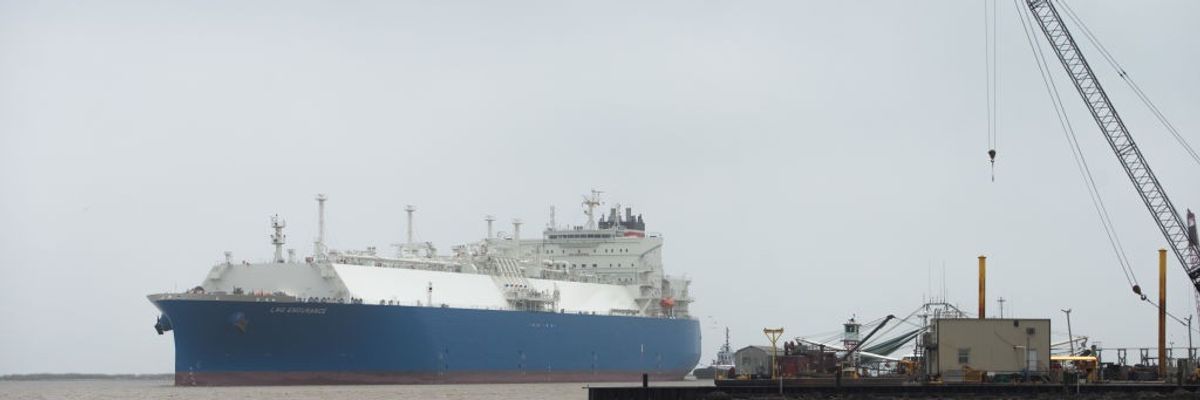Feds to Vote on CP2 Project as Climate Campaigners Protest LNG Buildout
"FERC's approval of this massive new LNG export facility would cut through the heart of President Biden's LNG pause, realizing one of the largest fossil fuel export projects ever proposed in the United States," an expert said.
The Federal Energy Regulatory Commission will formally consider issuing a permit for the Calcasieu Pass 2 export terminal, a major fossil fuel infrastructure project in Louisiana that environmental campaigners oppose, according to a notice the agency released Thursday.
It will come to a vote at the agency's June 27 meeting, E&E News reported.
Environmentalists campaigned against the project last year but quieted down after the Biden administration paused all liquefied natural gas (LNG) exports to non-Fair Trade Agreement countries in January.
The planned terminal, owned by Venture Global and often called CP2, has been noticeably absent from FERC meeting agendas since last July, when the agency published the environmental impact statement. Venture and other corporate interests have pressured the agency to move the project, which is located near the Gulf of Mexico in western Louisiana, up on the agenda—and finally gotten their wish.
Advocacy groups urged the federal agency to deny the permit.
"FERC's approval of this massive new LNG export facility would cut through the heart of President [Joe] Biden's LNG pause, realizing one of the largest fossil fuel export projects ever proposed in the United States," Food & Water Watch policy director Jim Walsh said in a statement.
"Biden claims to be concerned by the devastating climate and environmental impacts of continued LNG development, yet the country is on track to export more and more LNG for years to come—with or without his temporary partial pause," he added.
CP2 is modeled on the existing Calcasieu Pass terminal (CP1), which began operations in January 2022 and has been the subject of scrutiny not just for its role in the distribution of fracked gas but also for a series of deviations from permitted activities, including alleged flaring that the company didn't report and the accidental release of 180,099 pounds of gas.
The planned site for CP2 is an area of wetlands next to CP1. Venture says that it's already started off-site construction and spent billions of dollars on CP2 and, with speedy government approval, would begin shipping LNG from the facility in 2026, according to LNGPrime.
If FERC were to approve the project, the U.S. Department of Energy would still have a statutory duty to approve future exports, but DOE is required to do so quickly, Walsh of Food & Water Watch told Common Dreams. Still, a key holdup for Venture would be the pause on exporting LNG to countries without free trade agreements—many of the company's contracts are with such countries, Walsh said.
FERC's slowness to place CP2 on its agenda was "welcomed," Walsh said, but "a real victory will be FERC rejecting this project, and failing that, President Biden's DOE denying their export license."
Walsh expressed concern that the U.S. "continues to ramp up export capacity even as we have a pause on new LNG export approvals."
Environmental and community groups have called on the Biden administration to ban LNG exports permanently, as Common Dreams reported last month, and a key part of that effort is blocking CP2 and closing CP1, they contend.
The groups have allies at the national level who've tried to draw attention to a project whose importance has often been overlooked.
Environmental campaigner and journalist Bill McKibben, who wrote a piece about CP2 for The New Yorker last year, has called the project "an environmental justice train wreck." He wrote in Common Dreams that CP2 is like Keystone XL "but with perhaps even more at stake." He also said that it could end up creating more than 20 times the emissions of the controversial Willow project in Alaska.

A liquefied natural gas (LNG) tanker operates near a Venture Global export facility in Louisiana.

No comments:
Post a Comment
Note: Only a member of this blog may post a comment.